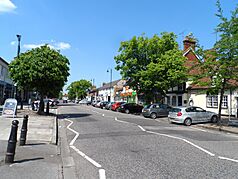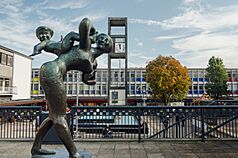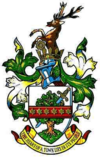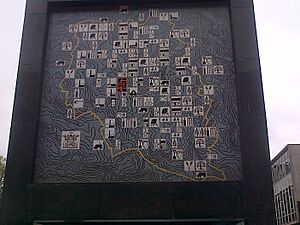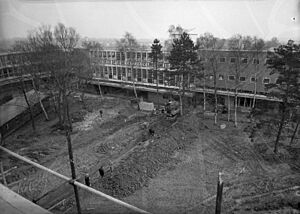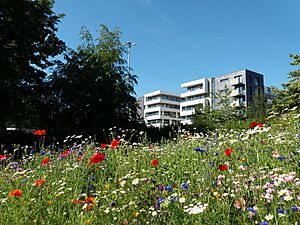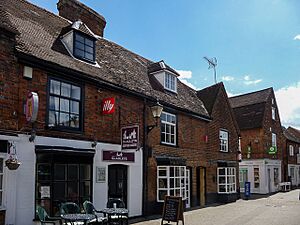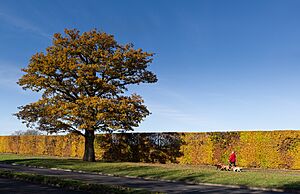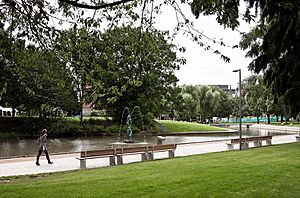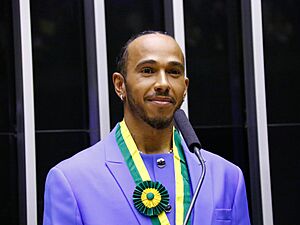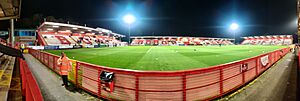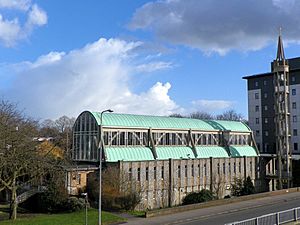Stevenage facts for kids
Quick facts for kids
Stevenage
|
||
|---|---|---|
|
The old town centre
The new town centre with the clock tower fountain and Franta Belsky Joyride statue
|
||
|
||
| Motto(s):
"The heart of a town lies in its people"
|
||
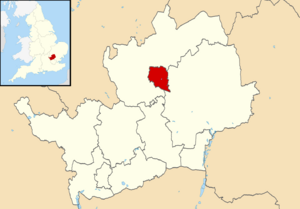
Stevenage shown within Hertfordshire
|
||
| Sovereign state | ||
| Constituent country | ||
| Region | East of England | |
| Ceremonial county | Hertfordshire | |
| Admin HQ | Stevenage | |
| Government | ||
| • Type | Non-metropolitan district | |
| Area | ||
| • Total | 25.96 km2 (10.02 sq mi) | |
| Population
(2005 est.)
|
||
| • Total | 87,845 (Ranked 276th) | |
| • Density | 3,081/km2 (7,980/sq mi) | |
| Ethnicity (2021) | ||
| • Ethnic groups |
List
|
|
| Religion (2021) | ||
| • Religion |
List
44.9% no religion
43.3% Christianity 8.6% other 3.2% Islam |
|
| Time zone | UTC+0 (Greenwich Mean Time) | |
| Postcode areas |
SG1, SG2
|
|
| Area code(s) | 01438 | |
| ONS code | 26UH (ONS) E07000243 (GSS) |
|
| OS grid reference | TL2424 | |
| Police | Hertfordshire | |
| Fire | Hertfordshire | |
| Ambulance | East of England | |
Stevenage (/ˈstiːvənɪdʒ/ stee-VƏN-ij) is a town and borough in Hertfordshire, England. It is about 27 miles north of London. Stevenage is located east of junctions 7 and 8 of the A1(M). It sits between Letchworth Garden City to the north and Welwyn Garden City to the south. In 1946, Stevenage became the United Kingdom's first New Town under the New Towns Act.
Contents
- What's in a Name? The Etymology of Stevenage
- A Journey Through Time: Stevenage's History
- Stevenage New Town: How it Grew
- Stevenage's Climate
- How Stevenage is Governed
- Stevenage's Population and People
- Sports and Fun Activities in Stevenage
- Stevenage's Culture and Media
- Nearby Places to Explore
- Getting Around: Transport in Stevenage
- Learning in Stevenage: Schools and Colleges
- Places of Worship in Stevenage
- Famous People from Stevenage
- Stevenage's Twin Towns
- See also
What's in a Name? The Etymology of Stevenage
The name Stevenage might come from an old English phrase. It could mean "place at the stiff oak tree."
The name was written as Stithenæce around 1060. It was also recorded as Stigenace in the Domesday Book in 1086.
A Journey Through Time: Stevenage's History
Stevenage is located near an old Roman road that connected Verulamium to Baldock. During the building of the New Town, some Roman-British remains were found. In 1986, a treasure of 2,000 silver Roman coins was discovered in the Chells Manor area. The most important Roman evidence is Six Hills. These are six large mounds, called tumuli, next to the old Great North Road. They were probably burial places for a local family.
After the Romans, the first Saxon camp was set up in a forest clearing. This is where the church, manor house, and first village were later built. Other small settlements also appeared in Chells, Broadwater, and Shephall.
In the Domesday Book, the Lord of the Manor was the Abbot of Westminster Abbey. The town moved closer to the Great North Road. In 1281, Stevenage received a Royal Charter. This allowed it to hold a weekly market and an annual fair. These events are still held in the High Street today.
The oldest part of St Nicholas' Church was built in the 12th century. However, people likely worshipped there much earlier. We have a list of priests and rectors from 1213 onwards.
Around 1500, the church was greatly improved. It received decorative woodwork and a clerestory, which added more windows.
In 1558, Thomas Alleyne, a local rector, started a free grammar school for boys. This school, Alleyne's Grammar School, has been open continuously until 1989. It is now a mixed comprehensive school and an Academy. It still stands on its original site at the north end of the High Street.
Stevenage became successful partly because of the North Road. This road became a turnpike in the early 18th century. Many inns on the High Street served stage coaches. In 1800, 21 stage coaches passed through Stevenage every day.
In 1857, the Great Northern Railway was built. This meant the end of the stage coach era. Stevenage grew slowly during the 19th century. A second church, Holy Trinity, was built at the south end of the High Street. In 1861, the writer Charles Dickens described the town as "drowsy in the dullest degree."
In 1928, Philip Vincent bought the HRD Motorcycle Co Ltd. He moved it to Stevenage and renamed it the Vincent HRD Motorcycle Co Ltd. This company made famous motorcycles, like the Black Shadow, in Stevenage until 1955.
Modern Stevenage: A New Town is Born
After the Second World War, a plan called the Abercrombie Plan suggested building new towns around London. Stevenage was chosen as the first New Town on August 1, 1946.
Local people were not happy about this plan. They protested at a meeting with Lewis Silkin, a government minister. When Silkin arrived, some people had changed the signs from 'Stevenage' to 'Silkingrad'. Silkin told the crowd of 3,000 people, "It's no good your jeering, it's going to be done." Even though 52% of residents were against it, the plan went ahead. The first major building torn down was the Old Town Hall, where the protests had taken place.
In 1949, Dr Monica Felton became the head of the Stevenage Development Corporation. She was removed from her job within two years.
The town was designed with six separate neighborhoods. The first two, Stoney Hall and Monks Wood 'Estates', were ready in 1951. The Twin Foxes pub in Monks Wood was Stevenage's first new pub. It was named after famous local twin poachers, Albert Ebenezer and Ebenezer Albert Fox.
Other neighborhoods built were Bedwell (1952), Broadwater and Shephall (1953), Chells (1960s), and later Pin Green and Symonds Green. A newer area called Great Ashby is still being built to the north. The government also provided almost £2 million for a homeless shelter for Hertfordshire.
Two other pubs have links to local history. The "Edward the Confessor" pub (now closed) might have been connected to St Mary's Church in nearby Walkern. This church was built around the time King Edward ruled (1042-1066). The "Our Mutual Friend" pub in Broadwater is named after a novel by Charles Dickens. Dickens often visited Sir Edward Bulwer-Lytton at Knebworth House and knew Stevenage well.
The town centre was the first traffic-free shopping area in Britain. It officially opened in 1959 with a visit from the Queen. Near the clock tower and a pool is a sculpture called Joyride, showing a mother and child. While it was very modern for its time, the town centre is now being planned for a big makeover.
Plans for a £250 million redevelopment of the shopping area were stopped in 2012. This was due to economic problems. The plans included new streets, moving the bus station, and building new shops, a cinema, hotel, restaurants, and apartments.
The Town Centre Regeneration Strategy (2002) aimed for better shops, improved public transport, and more housing. It also wanted better public facilities and more office space. Some well-known stores, like Maplin Electronics and Marks & Spencer, have closed in Stevenage town centre.
Stevenage has a large central library in Southgate. It offers printing, fax, photocopying, children's events, study areas, and public computers. There is also a smaller library in the High Street in the Old Town.
Next to the Town Garden is the Church of St Andrew and St George. It is a modern church design and has housed Stevenage Museum in its crypt since 1976. This church is a Grade 2 listed building. It is also the largest parish church built in England since World War Two.
Queen Elizabeth the Queen Mother laid the foundation stone in July 1956. She was also there for the consecration of the Bishop of St Alban's in 1960. The church's frame is made from concrete poured into molds. This creates unique interlacing arches with no visible joints. There are twelve columns made of Purbeck-marble around the main altar. The outside walls are covered with Normandy pebble panels. The bell tower has loudspeakers for an electro-acoustic carillon. A popular sculpture, 'The Urban Elephant' by Andrew Burton, was added in 1992.
North of Stevenage Old Town, near St Nicholas' Church, is Rooks' Nest. This was the home of novelist E. M. Forster from 1884 to 1894. Forster used Rooksnest and the area around it as the setting for his novel Howards End. The land north of St Nicholas' Church is called Forster Country. It is the last farmland within Stevenage borough. Forster was not happy about the new Stevenage being built.
Close to Stevenage is Knebworth House. This gothic stately home has hosted famous rock concerts since 1974. It was once home to Sir Edward Bulwer-Lytton, a Victorian novelist.
In 1999, a millennium countdown clock was placed on the town centre clock tower. It showed the time left until the year 2000. A student designed the artwork on the clock.
The Industrial Area is separate from the residential parts of town. For many years, British Aerospace (now MBDA) was the biggest employer. Now, GlaxoSmithKline (GSK) has a large research laboratory complex there. Astrium (part of Airbus Defence and Space) has also made spacecraft in Stevenage for decades.
Many small and medium-sized companies are also in Stevenage. Stevenage BioScience Catalyst, a new science park, opened in 2011 next to GSK. It aims to attract small life-sciences businesses.
The town is still growing. It is planned to expand west of the A1(M) motorway. A major new development is Great Ashby to the north-east.
Stevenage hosts annual events like Stevenage Day and Rock in the Park. In 2016, Stevenage celebrated its 70th anniversary as a New Town.
Stevenage New Town: How it Grew
Stevenage grew slowly until after the Second World War. Then, the Abercrombie Plan suggested creating new towns around London. On August 1, 1946, Stevenage was chosen as the first New Town under the New Towns Act.
The plan was not popular with local people. They protested at a meeting with Lewis Silkin, a government minister. As Silkin arrived, some people changed the signs to 'Silkingrad'. Silkin told the crowd of 3,000 people that the plan would happen anyway. Despite the protests, the plan went ahead. The Old Town Hall, where the protests happened, was later demolished in 1974.
The first head of the Stevenage Development Corporation was Clough Williams-Ellis. Dr Monica Felton was his deputy. She later became chairman but was removed within two years. She was replaced by Allan Duff and then Thomas Bennett. Gordon Stephenson was the planner, Peter Shepheard the architect, and Eric Claxton the engineer. Claxton believed in separating bicycle paths from roads. Mary Tabor was the Housing Director from 1951 to 1972. She provided a very caring service to the town's residents.
In 1953, Sir Roydon Dash became chairman. In 1962, Sir Arthur Rucker took over, and then Evelyn Denington, Baroness Denington became chairman in 1966. She stayed until the Corporation closed in 1980. She was even given the title Baroness Denington of Stevenage.
The town was planned with six self-contained neighborhoods. Stoney Hall and Monks Wood were the first to be occupied in 1951. The Twin Foxes pub in Monks Wood was Stevenage's first new pub. It was named after local twin poachers, Albert and Ebenezer Fox. It closed in 2017.
Other neighborhoods built were Bedwell (1952), Broadwater and Shephall (1953), Chells (1960s), and later Pin Green and Symonds Green. Great Ashby, a new development to the north, was still being built in 2014. The government provided almost £2 million for a homeless shelter for Hertfordshire.
Stevenage's Industrial Area
The main industrial area is separate from the homes in town. British Aerospace (now MBDA) used to be the largest employer. Now, GSK has a large research and development center there.
Airbus Defence and Space (formerly British Aerospace) is also in a smaller industrial park. This is where spacecraft like the Rosalind Franklin rover and the Solar Orbiter are put together. They also analyze other projects, like the Mars Earth Return Orbiter.
Many small and medium-sized companies are also in Stevenage. Stevenage BioScience Catalyst (SBC), a new science park, opened in 2011 next to GSK. It helps small and new life-sciences businesses.
Stevenage Town Centre: Shopping and Culture
The pedestrianized town centre was the first traffic-free shopping area in Britain. It was inspired by the Lijnbaan in Rotterdam and opened in 1959 by the Queen. A key landmark is the clock tower and a decorative pool. Nearby is Joyride, a sculpture of a mother and child.
Next to the Town Garden, the Church of St Andrew and St George is a modern church. It has housed Stevenage Museum in its crypt since 1976. This church is a Grade 2 listed building. It is also the largest parish church built in England since World War Two. Queen Elizabeth the Queen Mother laid its foundation stone in 1956. The church's frame is made of concrete, forming interlacing arches. It has twelve Purbeck-marble columns and external walls covered with Normandy pebble. The bell tower has loudspeakers for an electro-acoustic carillon. A sculpture called 'The Urban Elephant' was added in 1992.
Although the town centre was very modern for its time, it is now showing its age. In 2005, plans for a major regeneration were announced. However, multi-million-pound plans were stopped in 2012 due to economic problems.
Events and Celebrations
Stevenage holds several annual events. These include Stevenage Day and Rock in the Park. In June 2022, Stevenage Day returned to celebrate the platinum jubilee of Elizabeth II. It was the first carnival since 2019 due to the coronavirus pandemic.
In 2016, Stevenage celebrated its 70th anniversary as a New Town.
Future Plans for Stevenage
The Town Centre Regeneration Strategy (2002) aimed for better shops, improved public transport, and more housing. It also wanted better public facilities and more office space. Some well-known stores, like Maplin Electronics and Marks & Spencer, have closed in Stevenage town centre.
The town has a large central library in Southgate. It offers printing, fax, photocopying, children's events, study areas, and public computers. There is also a smaller library in the High Street in the Old Town.
The town is still growing. It is planned to expand west of the A1(M) motorway. A major new development is Great Ashby to the north-east.
Stevenage's Regeneration Project
Stevenage and the Stevenage First partnership have started a new £1 billion, 20-year plan. This plan aims to transform central areas and add new homes, businesses, and shops. It includes the £350 million ‘SG1’ program and the £50 million redevelopment of Queensway North. Stevenage's Town Square is also being updated with new bars, restaurants, and shops. These plans are based on the local government's Local Plan, approved in March 2019.
A new public services hub will bring many services into one central location. A new Bus Interchange opened on June 26, 2022. It is closer to the train station and next to the Gordon Craig Theatre. Many other developments are already finished or underway.
Stevenage's Climate
Stevenage has an oceanic climate (Köppen climate classification Cfb). This is similar to most of the United Kingdom.
| Climate data for Stevenage | |||||||||||||
|---|---|---|---|---|---|---|---|---|---|---|---|---|---|
| Month | Jan | Feb | Mar | Apr | May | Jun | Jul | Aug | Sep | Oct | Nov | Dec | Year |
| Mean daily maximum °C (°F) | 7 (45) |
8 (46) |
11 (52) |
13 (55) |
17 (63) |
19 (66) |
22 (72) |
23 (73) |
19 (66) |
14 (57) |
10 (50) |
7 (45) |
14 (57) |
| Mean daily minimum °C (°F) | 2 (36) |
2 (36) |
4 (39) |
4 (39) |
7 (45) |
10 (50) |
12 (54) |
12 (54) |
10 (50) |
8 (46) |
5 (41) |
3 (37) |
7 (45) |
| Average precipitation mm (inches) | 45.1 (1.78) |
33.9 (1.33) |
28.7 (1.13) |
43.9 (1.73) |
34.9 (1.37) |
46.6 (1.83) |
42.1 (1.66) |
46.9 (1.85) |
54.9 (2.16) |
56.8 (2.24) |
48.0 (1.89) |
49.8 (1.96) |
531.6 (20.93) |
How Stevenage is Governed
| Stevenage | |
| Geography | |
| HQ | Stevenage |
| History | |
| Created | 2 October 1873 |
| Abolished | 31 March 1974 |
| Succeeded by | Stevenage Borough Council |
| Demography | |
|---|---|
| 1891 population | 3,309 |
| 1971 population | 66,585 |
Stevenage has two levels of local government: the Stevenage Borough Council and the Hertfordshire County Council.
Stevenage was an ancient parish. In 1873, the town voted to become a Local Government District. This meant it would be governed by a Local Board. The first meeting of this board was on December 4, 1873. Its first chairman was George Becher Blomfield, the rector of St Nicholas' church.
In 1894, the Local Board became the Stevenage Urban District Council. Stevenage Urban District grew several times, including absorbing the parish of Shephall in 1953. The council moved its offices to Southgate House in 1964. In 1980, it moved to Daneshill House, which used to be the New Town Corporation's headquarters.
On April 1, 1974, Stevenage became a non-metropolitan district. It was also given borough status on the same day. Since then, it has been governed by the Stevenage Borough Council.
Stevenage's Population and People
The population of Stevenage grew a lot during the 20th century. In 1801, it was a large village with 1,430 people. By 1901, it had grown to 4,048.
After Stevenage was named a new town in 1946, its population increased rapidly. By 2001, the population was 79,715. It reached 83,957 in 2011. In 2016, the population was estimated to be 87,100.
Religion in Stevenage
Based on the 2021 census, here's the religious makeup:
| Area | All people | Christian (%) | Buddhist (%) | Hindu (%) | Jewish (%) | Muslim (%) | Sikh (%) | Other (%) | No religion (%) | Not stated (%) |
|---|---|---|---|---|---|---|---|---|---|---|
| England and Wales | 56,490,048 | 46.3 | 0.5 | 1.8 | 0.5 | 6.7 | 0.9 | 0.6 | 36.7 | 6.0 |
| Stevenage | 89,495 | 43.26 | 0.44 | 1.56 | 0.18 | 3.15 | 0.34 | 0.58 | 44.87 | 5.60 |
Sports and Fun Activities in Stevenage
King George's Field is named after King George V. It is home to Stevenage Cricket Club, Stevenage Hockey Club, and Stevenage Town Bowls Club. The cricket ground is called Ditchmore Lane. The nearby Stevenage Leisure Park has a cinema, clubs, and restaurants. The main shopping areas are Queensway and Westgate. In the south of town, there is a retail park called 9Yards. It used to be called Roaring Meg, named after a stream that runs under it. There are also shops in the Old Town. 9Yards once had an ice rink and bowling alley, but these were removed in 2000 for more stores.
Stevenage FC, also known as Stevenage Borough, is the town's main football team. They play their home games at Broadhall Way. The club started in 1976. They were promoted to the Football Conference in 1994. After 16 seasons, Stevenage won the Conference Premier title in 2009–10. They had been denied promotion before due to ground issues. In their first season as a Football League club, they earned back-to-back promotions to League One.
Stevenage also won the FA Trophy in 2007. They beat Kidderminster Harriers 3–2 at Wembley Stadium. This was the first competitive club game and cup final at the new stadium. Stevenage reached the final again in 2009, winning 2–0 against York City. The club has also had good runs in the FA Cup. In 1997–98, Stevenage drew with Premier League team Newcastle United at home. In 2010, they beat Newcastle 3–1 at home. The next season, Stevenage drew 0–0 with Tottenham Hotspur at home.
The town has other successful sports clubs. These include a women's football team (Stevenage Borough Ladies FC) and Stevenage Town Rugby Club. Many famous athletes are from Stevenage. These include footballers Kevin Phillips and Ashley Young, seven-time Formula One World Champion Lewis Hamilton, and golfer Ian Poulter.
Fairlands Valley is a large park with boating lakes. It hosts a Parkrun. Stevenage is a very green town with many tree-lined avenues. It also has large woods like Monks & Whomerley Wood. The Woodland Trust says it's one of the best places in the UK for easy access to large woodlands. There are also many playing fields, and schools have substantial grounds.
Stevenage also has a basketball team called East Herts Royals.
The town is surrounded by the Stevenage Outer Orbital Path (STOOP). This is a 27-mile circuit walk started in 2008. It offers a fun way for residents to be active. The STOOP is divided into sections and can be accessed from the town. The route goes through nearby villages like Graveley and Knebworth Park. It was launched on September 20, 2008.
Stevenage's Culture and Media
A small community arts centre is located in the 9Yards Retail Park. The Boxfield and Foyer Gallery are inside the Gordon Craig Theatre. Stevenage Museum is located under the St. Andrew and St. George's church.
Local news and TV shows are provided by BBC East and BBC London on BBC One. ITV Anglia and ITV London are on ITV. TV signals come from either the Sandy Heath or Crystal Palace transmitters.
Local radio stations include BBC Three Counties Radio on 90.4 FM and Heart Hertfordshire on 106.7 FM.
The Comet is the town's weekly local newspaper.
Nearby Places to Explore
North of Stevenage Old Town, near St Nicholas' Church, is Rooks' Nest. This was the home of novelist E. M. Forster from 1884 to 1894. Forster used Rooksnest and the area around it as the setting for his novel Howards End. The land north of St Nicholas' Church is called Forster Country. It is the last farmland within Stevenage borough. Forster was not happy about the new Stevenage being built.
In spring 2023, Forster Country was threatened by new housing. 2,000 people asked the council to rethink plans for a car park, landfill, and power station in the park.
To the south of Stevenage is Knebworth House. This gothic stately home has hosted famous rock concerts since 1974. It was once home to Sir Edward Bulwer-Lytton, a Victorian novelist.
Astonbury Wood, south-east of Stevenage, is a nature reserve. It is an ancient woodland covering 54 hectares.
Getting Around: Transport in Stevenage
Stevenage has a unique urban design. It has many roundabouts, few traffic lights, and a network of separate cycleways. It also has some of the tallest street lights in Britain. Eric Claxton, chief engineer from 1962 to 1972, planned and built this cycle network. Despite this, only 2.7% of people use bicycles to get around. Claxton also wanted as few traffic lights as possible, preferring roundabouts.
The A1(M) motorway goes around the west side of the town. Work on this 7.5-mile bypass started in 1960. The old Great North Road, partly called the B197, runs through the town. The Old Town's High Street has several pubs that used to be coaching inns. The A602 connects Stevenage to Hitchin, Watton-at-Stone, Hertford, and Ware.
The main bus company is Arriva Herts & Essex. They run over 10 routes in and around the town. They also have services to Luton, St Albans, Welwyn Garden City, and Letchworth Garden City. Another bus company is unō. They run the 635 route between Watford and Hitchin via Stevenage. Centrebus also operates some services.
On June 26, 2022, the new Stevenage Interchange opened. It replaced the old bus station, which was needed for redevelopment. The new bus station has toilets, a heated waiting room, a small shop, and a café. It has 10 bus stands. There is also a coach stand for services like the FlixBus route between Cambridge and London.
Stevenage railway station is on the East Coast Main Line. It has regular services to London King's Cross (24 minutes) and Cambridge (37 minutes). There are also connections to northern England and Scotland.
Learning in Stevenage: Schools and Colleges
Many schools were built in the 1950s and 60s because many people moved from London to Stevenage. The town has about 23 primary schools. Some children go to schools in nearby villages like Aston and Walkern. Stevenage also has several secondary schools and the main campus for North Hertfordshire College.
Primary Schools in Stevenage
- Almond Hill Junior
- Ashtree Primary School and Nursery
- Bedwell Primary School and Nursery
- Broom Barns Community Primary
- Camps Hill Community Primary
- Fairlands Primary School and Nursery
- Featherstone Wood Primary School and Nursery
- Giles Junior
- Giles Nursery and Infants
- Letchmore Infants' and Nursery
- The Leys Primary and Nursery
- Lodge Farm Primary
- Longmeadow Primary
- Martins Wood Primary
- Moss Bury Primary School and Nursery
- Peartree Spring Primary
- Roebuck Primary School and Nursery
- Shephalbury Park Primary
- St Margaret Clitherow Roman Catholic Primary
- St Nicholas C of E Primary School and Nursery
- St Vincent de Paul Catholic Primary
- Trotts Hill Primary and Nursery
- Woolenwick Infant and Nursery
- Woolenwick JM
Special Needs Schools in Stevenage
- Larwood Primary
- Lonsdale
- Greenside
- The Valley Secondary
- Barnwell (includes special bases for visually impaired and specific learning difficulties)
Secondary Schools in Stevenage
- Barnwell School – has two campuses.
- Barclay Academy
- The John Henry Newman School – specializes in arts.
- Marriotts School – a sports college.
- The Nobel School – specializes in performing arts and science.
- The Thomas Alleyne Academy
Colleges in Stevenage
- North Hertfordshire College (Stevenage Campus)
Places of Worship in Stevenage
Stevenage has many Christian churches. Many of them work together through "Churches Together in Stevenage." The town also has a mosque and a Liberal Jewish Synagogue. There is also an "Interfaith Forum" for different religions to talk and learn from each other.
Some of the places of worship include:
- All Saints Church (Anglican/Methodist Union)
- Bunyan Baptist Church
- Christ the King Church (Anglican)
- City of David Church (Redeemed Christian Church of God)
- The Cathedral of Saint George (Coptic Orthodox)
- Elim Pentecostal Church
- Grace Community Church (Newfrontiers)
- Great Ashby Community Church (Anglican/Baptist Joint Project)
- High Street Methodist Church
- Holy Trinity Church (Anglican)
- Kingdom Hall of Jehovah's Witnesses
- Longmeadow Evangelical Church
- Friends Meeting House (Quakers)
- Oak Church Stevenage – A youth-focused Anglican Church
- Roman Catholic Church of St Hilda
- Roman Catholic Church of St Joseph
- Roman Catholic Church of the Transfiguration
- Salvation Army Corps
- Church of St Andrew & St George (Anglican)
- Seventh-day Adventist Church
- Stevenage Liberal Synagogue (Liberal Judaism)
- Stevenage Muslim Community Centre
- St Hugh & St John Church (Anglican/Methodist Union)
- St Mary's Church (Anglican)
- St Nicholas' Church (Anglican)
- St Paul's Church (Methodist)
- St Peter's Church (Anglican)
- Stevenage Vineyard Fellowship
- The Church of Jesus Christ of Latter-day Saints – Stevenage Ward
- United Reformed Church
- Whomerley Spiritual Church & Centre
Famous People from Stevenage
Many notable people have connections to Stevenage:
- Omo Aikeremiokha (born 2005), trampoline gymnast
- Daniel Ballard (b. 1999), Sunderland A.F.C. footballer
- Harry Bates (1850–1899), sculptor
- Oliver Cheshire (b. 1988), fashion model
- Sir Thomas Clarke (b. 1527), knighted by Henry VIII.
- E. E. Cowper (1859–1930), novelist
- Edward Gordon Craig (1872–1966), scenographer and theatre theorist
- Andrew Croft (1906–1991) explorer and SOE (Special Operations Executive) agent
- David Croft (b. 1970), Commentator for Sky Sports F1
- Keinan Davis (b. 1998), Aston Villa footballer
- Mark E'Beyer (b. 1984), footballer
- Albert and Ebenezer Fox (1857–1926, 1857–1936), famous poachers
- Marshall Frost (born 2005), trampoline gymnast
- Gabz Gardiner, finalist in Britain's Got Talent
- Jack Gladman (b. 1997), International Para Athlete and Pro Boxing Matchmaker
- Sir Lewis Hamilton (b. 1985), 7-time Formula One World Champion
- Nicolas Hamilton (b. 1992), racing driver
- Peter Harper (1921–2003) International Rally Driver
- Aleks Josh, contestant on The Voice UK
- William Jowitt, 1st Earl Jowitt (1885–1957), Lord High Chancellor
- Nadeem Leigh, contestant on The Voice UK
- Cathy Lesurf, singer
- Edward Morse (born 1986), English cricketer
- Richard Norwood (c. 1590–1675), first person to survey Bermuda
- Alex Pettyfer (b. 1990), actor
- Elizabeth Poston, composer
- Jason Shackell (b. 1983), footballer
- Henry Trigg (c. 1667–1724), local grocer known for his unusual will
- Sam Wallace, Chief Football Writer at The Daily Telegraph
- Ed Westwick (b. 1987), actor
- Ben Wilmot (b. 1999), Stoke City F.C. footballer
- Karen Woo, surgeon, killed in Afghanistan
- Anthony (Tony) John Wright (b. 1962), cricketer
- Ashley Young (b. 1985), current Everton footballer and former Manchester United captain
- Gary Younge, (b. 1969), journalist, author.
- People who lived in Stevenage
- George Brown (1912–79), motorcyclist
- Francis Cammaerts (1916–2006), French Resistance leader
- John Cooper Clarke, performance poet
- Evelyn Denington, Baroness Denington (1907–1998), politician
- Denholm Elliott (1922–1992), actor
- Thomas Fellowes (1827–1923), Royal Navy officer
- Ken Follett (born 1947), author
- E. M. Forster (1879–1970), novelist
- Tommy Hampson (1907–1965), Olympic athlete. Hampson Park is named after him.
- Ken Hensley (b. 1945), keyboard player for Uriah Heep
- Denis Ovens (b. 1957), former professional darts player
- Emma Kennedy (born 1967), actress and writer
- Stephen McPartland (born 1976), MP for Stevenage
- Wilf Mannion (1918–2000), English international footballer
- Miguel of Portugal, King of Portugal, is said to have lived on the High Street around 1845
- Lee "Scratch" Perry (1936–2021), Reggae artist and producer
- Leslie Phillips, actor, evacuated to Stevenage during the Second World War
- David Schaal, actor
- Naum Slutzky (1894–1965), designer
- John Thurloe (1616–1668), secretary to Oliver Cromwell
Stevenage's Twin Towns
Stevenage is twinned with several towns around the world:
| City | Country | Year |
|---|---|---|
| Ingelheim am Rhein | Germany | 1963 |
| Autun | France | 1975 |
| Kadoma | Zimbabwe | 1989 |
| Shymkent | Kazakhstan | 1990 |
See also
 In Spanish: Stevenage para niños
In Spanish: Stevenage para niños


